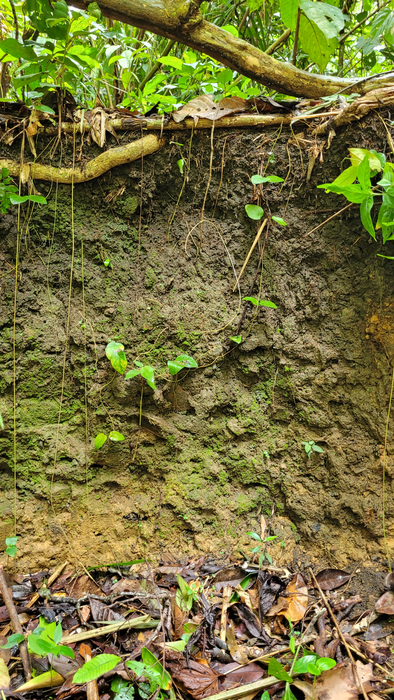A small-scale trial of rainforest restoration has met with success when performed using Amazonian dark earth (ADE), also known as terra preta, but failed using ordinary soil. A 1:4 mix of ADE and other soils saw some, but not all, species establish themselves. Bringing back devastated forests is likely to be one of the key challenges of the 21st Century, and Amazonian natives from 1,600 years ago may be our best guides.
The vast Amazon basin is dotted with patches of rich dark soils where the trees most useful to humans flourish as if domesticated while maintaining the wider forest’s extraordinary diversity. These dark earths show an apparently miraculous capacity to store carbon and boost plant growth and were deposited while other human populations were devastating the lands in which they lived.
Terra preta has been promoted as the key to fighting climate change and restoring ecosystems, but evidence for these claims is greatly disputed. A new paper describes a more rigorous test of how well ADE performs under conditions closer to those typically faced in forest restoration efforts.

Amazonian dark earth over ordinary Amazonian soil (yellow). It might not look different from soils elsewhere, but the microorganism profile and the forests that grow in it are exceptional. Image Credit: Luís Felipe Guandalin Zagatto
The authors collected ADE from a research station in the heart of the Amazon, and soil used for growing crops at a school of agriculture in São Paulo state. They placed 36 pots filled with ADE, agricultural soil, or one part ADE to four parts soil in a greenhouse heated to 34°C (93°F). The temperature deliberately exceeds existing temperatures to allow for future global heating, of which deforestation is a major cause.
For realism, the authors planted the pots with palisade grass, which frequently grows in Brazilian areas deforested to raise beef cattle. The authors note that in Brazil alone, 189 hectares (467 acres) of forest were lost every hour in 2021, mostly for cattle pastures.
Once grown, the grass was cut, but the roots left untouched, mimicking what happens after grazing. Finally, pots were replanted with seeds from three rainforest species: Ambay pumpwood (Cecropia pachystachya), Peltophorum dubium, and cedro blanco (Cedrela fissilis). These were chosen because Ambay is usually one of the first Amazonian trees to return after damage, P. dubium is typical of the second generation of forest plants, and cedro blanco is a sign of a restored forest.
After 90 days, not a single Ambay pumpwood had grown in either the agricultural or mixed soils, but all were doing well in the pure ADE. The other two trees grew in all three media, but did between two and six times better where ADE was present. For these, the pure ADE outperformed the mixture, but modestly so. If the pumpwood was ignored, the lower cost of the mixture might be considered worth the small difference.
The pumpwood’s failure in ordinary soils is surprising given its usual recovery; the paper proposes it was particularly affected by the high temperatures.
Consistent with previous observations, the ADE soils were much richer in a wide array of nutrients – including 30 times more phosphorus – at the start of the study, and less acidic. Some of these nutrients were quickly taken up by the plants. A more neglected factor was the array of microorganisms that thrived in the ADE and mixed soils, but not the control, and may have helped the plants access the nutrients.
ADE is a mixture of charcoal from low-intensity fires, animal bones, compost, manure, and even pottery. Modern scientists have struggled to recreate the exact formula. It’s thought to have been laid down over more than a thousand years. Rapid replication to match the scale of the forests needing restoration, in South America and elsewhere, will not be an easy task, even with modern capacities.
“Our recommendations aren’t to utilize ADE itself, but rather to copy its characteristics, particularly its microorganisms, for use in future ecological restoration projects,” said senior author Professor Siu Mui Tsai of the University of São Paulo in a statement.
The study is published in Frontiers in Soil Science.
Source Link: Indigenous Amazonian Soil Technology Key To Restoring Rainforests Worldwide